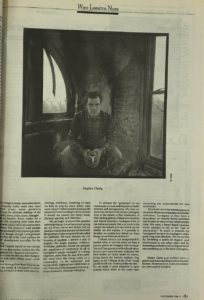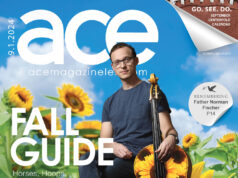What Lexington Needs by Stephen Clasby
Photo by M. Watt
November 1994 Ace
What Lexington needs: more demolition, shopping malls, more cars, more perimeter roads, more profiteers determining the physical makeup of the community, more, more, more… Enough!
 Let us breathe, focus, center for a moment. The wrecking balls have been wrested from what’s left of downtown for a brief season. The perimeter road pariahs have been sent back to their drawing boards. It looks as though enough Lexingtonians have had their fill of the “slash and burn the bluegrass” development mentality for the time being.
Let us breathe, focus, center for a moment. The wrecking balls have been wrested from what’s left of downtown for a brief season. The perimeter road pariahs have been sent back to their drawing boards. It looks as though enough Lexingtonians have had their fill of the “slash and burn the bluegrass” development mentality for the time being.
Before I brand myself as anti-change, and lead you, dear reader, to think that is an argument for “hysterical preservation,” allow me to state the obvious, that change is inevitable, and some things aren’t worth preserving.
Where do we go from here?
How do we address the needs of Lexington? Is there some scarcity, shortage, deficiency, something we have too little of, long for, crave, desire, wish, want, require. Is there something missing, the presence of which could give us the acumen to handle our present and future needs, physical, spiritual, and otherwise?
We can begin to answer this question only by giving up. It must be a proper giving up, not of our visions and desires, but we must give up the idea that any one answer to the question of what we need will solve all of our problems. We must abandon the old formula of question + answer = end of inquiry. No single planner, architect, developer, politician, mortal can generate the experience of community in all of Lexington’s people.
Lexington is a living organism, more than the sum of its parts.
We often view this living entity as a commodity, to be measured and manipulated, digitized and subdivided at will. New ways of thinking are in order (e.g., Urban Husbandry, Municipal Midwifery).
To address the “problems” of our community, we must look beyond our traffic patterns and demographics. We must see more than the face of our skyline. Lexington lives in the dreams of her inhabitants, in their passing glances, in their conversations and shared memories. Lexington lives in her colors and smells. She is as much in the unseen, the unbuilt as in that which we can readily see and explain. Is it possible to develop an architecture blend based on these things, an architecture of silence?
Cultural value is not always equal to market value, as one can easily see from a cursory glance at Lexington and environs. You can’t buy groceries with cultural value, but you can’t enjoy the meal without it. We have traded too many meals for menus, living history for historic markers.
Our legacy as the “Athens of the West” could quickly erode into “looks just like the rest.”
We can make it more attractive to save cultural relics while at the same time increasing our expectations for new architecture.
We inhabit one of the richest regions on the planet. Moreover, in this time of economic transition, Lexington is free from a dependence on obsolete heavy industries that burden so many of our contemporary cities.
We enjoy a broad based economy easily adapted to life in the “age of information.” So much is possible for Lexington if we have the foresight to make good, long-term decisions. We can do that by fostering a spirit of inquiry and involvement in our urban plans and by tempering our desire to see our big machines tear something up in the name of progress.
Stephen Clasby is an architect intern, a painter, and runs a small design and construction business. He maintains his studio and residence on a farm south of Lexington.
Subscribe to the Ace e-dition for Lexington news, arts, culture, food, and entertainment news delivered to your inbox every Thursday morning.








